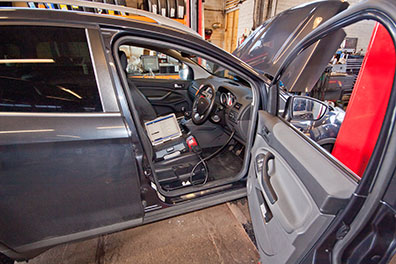The development of the internal combustion engine
In terms of development and improvement, the motor vehicle, and the internal combustion engine itself, have come a very long way since the very first Benz in 1885. The earliest powered-automobiles were complex for their time, but were incredibly basic in terms of their actual mechanical functioning. An internal combustion engine works by getting a mixture of fuel and air to burn very fast in a controlled way inside a cylinder. This drives a piston, the movement of which is converted mechanically into a rotating shaft to drive the wheels via gearing of some type. The 'trick' involved in the process is two-fold: first, getting the ideal mixture of fuel and air, and second, getting it to burn at precisely the correct moment. Of course, getting all this to happen reliably and efficiently has always been difficult, although modern technology has allowed vast improvements.

For the process of mixing fuel and air in a petrol-powered vehicle, from the earliest days right up to the end of the twentieth century, a carburetor was used. Initially extremely basic, a 'carb' works by spraying petrol into a moving flow of air, usually through a fine needle valve. The accuracy of any carburetor is determined by a number of factors. The precision manufacture of the valves is essential, of course, as is the ability to maintain a continuous flow of fuel under varying conditions, but the carb only works because air is being sucked through it by the working of the engine. This means that at different engine speeds, the air flow changes. Designing a carb to work correctly over a wide range of air flow is almost impossible and involves numerous compromises. The matter is further complicated by the fact that a carburetor has major problems when dealing with external changes, such as temperature and altitude. The wide-scale introduction of turbo-charging for engines caused a whole raft of additional issues, none of which were ever truly resolved. Mechanical fuel injection was tried, and was relatively successful. This involves a 'meter' and mechanical system spraying a measured amount of fuel directly into each engine cylinder at the correct time. Although far better than the basic carburetor, it still suffered from problems and the number of moving parts hampered long-term reliability and fuel economy.
Making the petrol and air mixture burn at exactly the right moment is the second vital issue. Many different methods have been tried, but the vast majority used (and still use) spark plugs worked by high-voltage electricity. An electrical circuit powers a coil, which in turn provides a very high voltage. This causes a spark across the electrodes of the spark plugs, igniting the mixture in the cylinders of the engine. Of course, this spark not only has to be generated at the correct time, but needs to be generated in the correct cylinder of the engine as well. Older vehicles use a 'distributor' for this. Inside, a pair of contacts open and close quickly, generating an electrical pulse to power the coil. Above this, a 'rotor arm' turns, distributing the spark via a number of electrodes to the correct spark plug. Whilst this system worked surprising well, it has numerous inherent weaknesses. The process means that the timing could never be exact, and would change with various factors. The components also wear and need fairly frequent adjustment. Worst of all, an old-fashioned distributor and system is incredibly prone to problems from moisture. Those of us with a long history of motoring remember the 'pleasures' of standing in the pouring rain with a cloth desperately trying to dry off the inside of a distributor in the hope of getting the car to start!
Diesel-powered engines differ fundamentally. Here, the fuel and air mixture is compressed to a very high degree (much more so than in a petrol engine). This process results in heat being produced and the mixture effectively ignites by itself. This means that an ignition system is not necessary. However, the timing and amount of fuel injected into the engine cylinders is crucial and because of the compression, very high pressures are needed. Initially, this was accomplished using a mechanical pump, but similar to mechanical fuel injection systems on cars, long-term reliability and economy were far from ideal.
 As with so many other things in the world today, developments in electronics have revolutionised the way internal combustion engines work. Early implementations included electronic
carburettors, where the amount of fuel sprayed into the flowing
air was more precisely measured, and changed according to engine speed. For the ignition system, early improvements replaced the troublesome contact breaker points with an electronic
device, removing the problems of wear and improving accuracy. For both petrol and diesel vehicles, electronic fuel injection systems enabled far more accurate control of the amount of
fuel supplied. The advent of the integrated circuit
and its refinement into powerful computer chips paved the way for these major changes. For the first time, engine manufacturers and designers were able to adjust the amount of fuel and
the timing of ignition with a previously undreamed of degree of accuracy. With the latest systems, a number of sensors measure a multitude of factors, including engine speed, external
and engine temperatures,
exhaust gas composition, altitude, humidity and road speed. All this information is put together to enable the system to provide the correct amount of fuel to ensure the best
combination of power and economy under many circumstances. The computer, in the form of an electronic control unit (or ECU for short) is programmed with a software 'map', which it
reads in order to work.
This map dictates the correct amount of fuel, ignition timing, pressure of a turbo-charger (if fitted) and other settings for a vast range of conditions.
As with so many other things in the world today, developments in electronics have revolutionised the way internal combustion engines work. Early implementations included electronic
carburettors, where the amount of fuel sprayed into the flowing
air was more precisely measured, and changed according to engine speed. For the ignition system, early improvements replaced the troublesome contact breaker points with an electronic
device, removing the problems of wear and improving accuracy. For both petrol and diesel vehicles, electronic fuel injection systems enabled far more accurate control of the amount of
fuel supplied. The advent of the integrated circuit
and its refinement into powerful computer chips paved the way for these major changes. For the first time, engine manufacturers and designers were able to adjust the amount of fuel and
the timing of ignition with a previously undreamed of degree of accuracy. With the latest systems, a number of sensors measure a multitude of factors, including engine speed, external
and engine temperatures,
exhaust gas composition, altitude, humidity and road speed. All this information is put together to enable the system to provide the correct amount of fuel to ensure the best
combination of power and economy under many circumstances. The computer, in the form of an electronic control unit (or ECU for short) is programmed with a software 'map', which it
reads in order to work.
This map dictates the correct amount of fuel, ignition timing, pressure of a turbo-charger (if fitted) and other settings for a vast range of conditions.
There are plenty of new developments on the way, with electric vehicles and hybrids (vehicles with an electric motor as well as a petrol or diesel engine) becoming more common and popular. Who knows what the next few centuries will bring?




